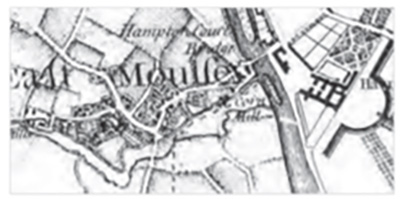We live in such a wonderful area, so packed with history and we are still able to see glimpses of the past. The river and Hampton Court are clearly a pull, but have you ever wandered around the East Molesey Conservation Area. The original village settlement of East Molesey is now formed into The Old Village Conservation Area and is based around St Mary’s Church. Now clearly no longer the village centre, the area retains buildings of various architectural styles and types including residential and commercial properties.
The earlier development of the settlement is associated with a former crossing point of the River Mole at Tanner’s Bridge. The earliest surviving map of the area is provided by Rocque c1770. This map confirms that Walton Road, St Mary’s Road and Bell Road had already assumed their modern form by the second half of the 18th century. Many of the principal surviving early buildings in the area are also clearly discernible on the Rocque map.
Matham Manor appears to be significantly larger than today and was set within extensive grounds. Within the grounds were long formal avenues of trees leading southeast towards the river. To the south west of the manor house, a carriageway is shown in approximately the same position as the modern Matham Road. It appears likely that the ‘u’ shaped form of Matham Road originates in this earlier garden feature within the grounds of the manor.
The earliest development is centred on the Church of St Mary and Bell Road leading to the crossing of the River Mole at Tanner’s Bridge. This is evidenced by the significant grouping of buildings from the 15th, 16th, and 17th centuries in this area. During the 18th century tanning took place to the north of Tanner’s Bridge and these buildings If you haven’t already, take a wander around the area. There are lots of things to see.
• Matham Manor House, 6 Matham Road (grade II) is the only surviving medieval building in the area and dates from the 15th century; Grade II listed Matham Manor in East Molesey, Surrey, was taken over by King Henry in the 1530s so he could build a huge hunting park around Hampton Court, his favourite palace. Matham Manor, the property is surrounded by original Tudor walls that once marked the edge of the Hampton Court Chase.
• The Bell Inn, Bell Road (grade II) dates from the mid-16th century and provided a useful staging post between London and the south coast;
• Park House, St Mary’s Road (grade II) incorporates a 17th century house;
• Quillets Royal, Bell Road (grade II) dates from the 16th century and was substantially extended in the 18th century by the addition of a range now known as ‘Old Manor House’. This was used as the parish workhouse in the 19th century;
• The Cottage and Green Arden (grade II), 30 Spencer Road, date from the 1720s;
• Church of St Mary (grade II) dates from 1865 and replaces a 12th century church on the site (demolished 1864);
• Late-19th century villas (local list) including 1, 3, 5, 25, 27, and 29 Matham Road;
• Late-19th century (local list) former fi re station adjoining no.1 Matham Road;
• No.32 Walton Road, a Regency villa of the 1820s with late-18th century origins.
Source : EBC/English Heritage/Various

